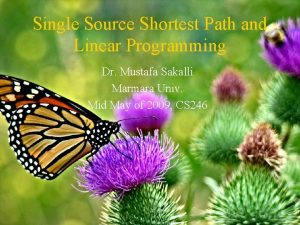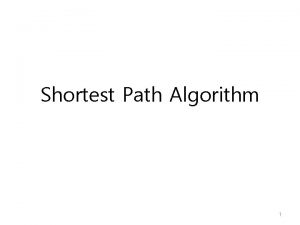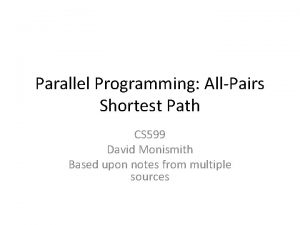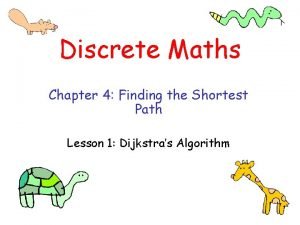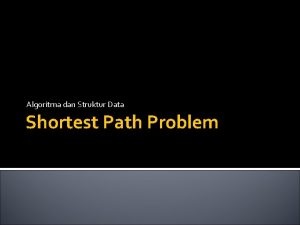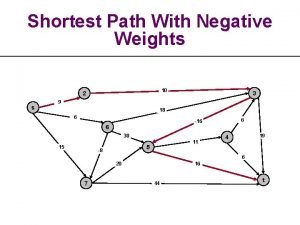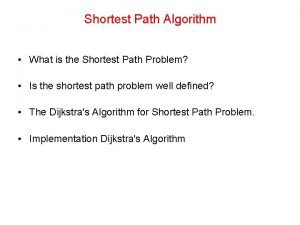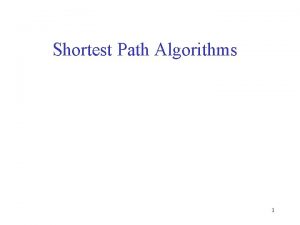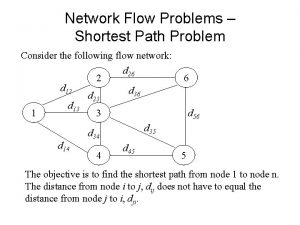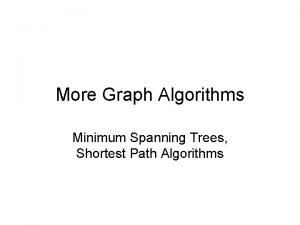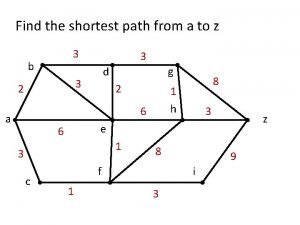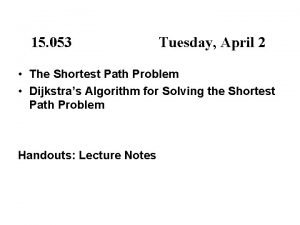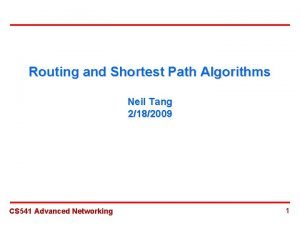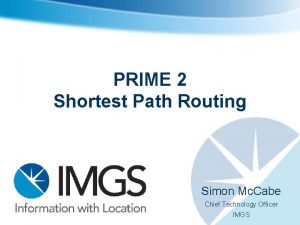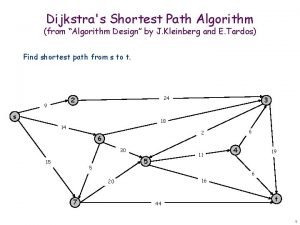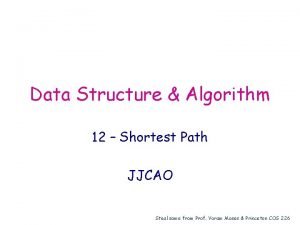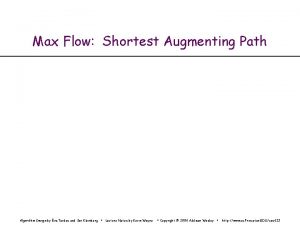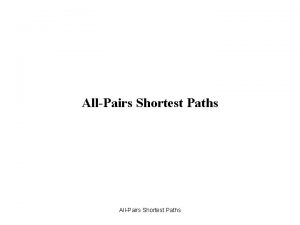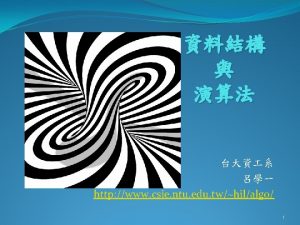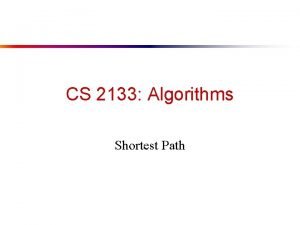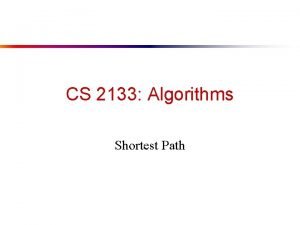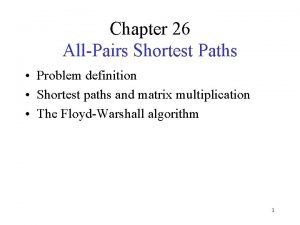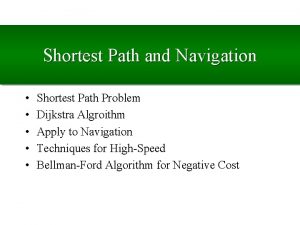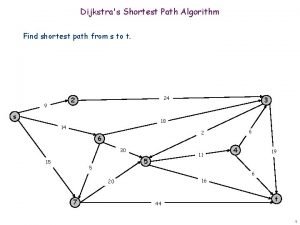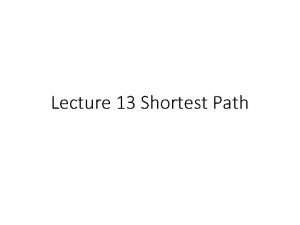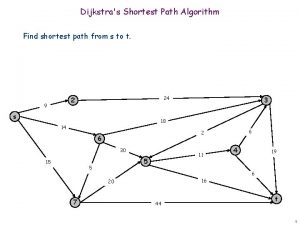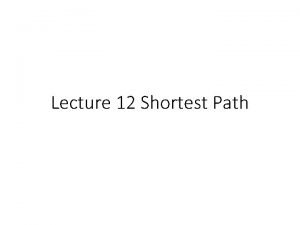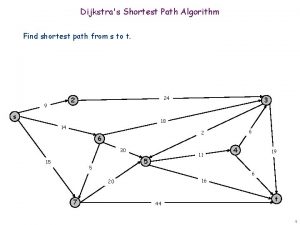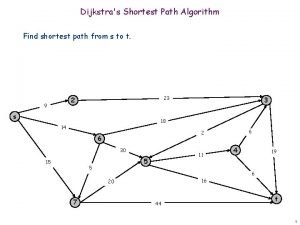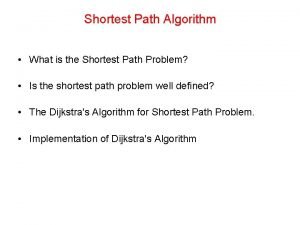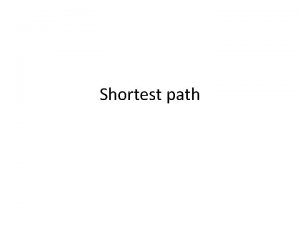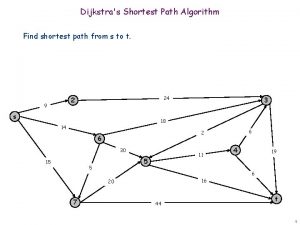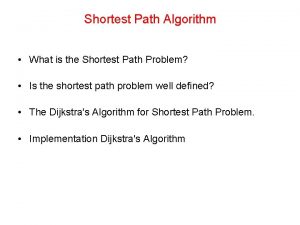Dynamic programming algorithms for allpairs shortest path and







![Computing the shortest-path weights bottom up: • • FLOYD-WARSHALL(W) n rows[W] D(0) W for Computing the shortest-path weights bottom up: • • FLOYD-WARSHALL(W) n rows[W] D(0) W for](https://slidetodoc.com/presentation_image_h2/f3487d6a83696818eb3644234d7fda14/image-8.jpg)









![The recursive equation • Let c[i, j] be the length of an LCS of The recursive equation • Let c[i, j] be the length of an LCS of](https://slidetodoc.com/presentation_image_h2/f3487d6a83696818eb3644234d7fda14/image-18.jpg)


![Constructing an LCS (back-tracking) • We can find an LCS using b[i, j]’s. • Constructing an LCS (back-tracking) • We can find an LCS using b[i, j]’s. •](https://slidetodoc.com/presentation_image_h2/f3487d6a83696818eb3644234d7fda14/image-21.jpg)

![Recursive Equation: • Let c[i, j] be the length of an LCS of X[1. Recursive Equation: • Let c[i, j] be the length of an LCS of X[1.](https://slidetodoc.com/presentation_image_h2/f3487d6a83696818eb3644234d7fda14/image-23.jpg)

- Slides: 24

Dynamic programming algorithms for all-pairs shortest path and longest common subsequences • We will study a new technique—dynamic programming algorithms (typically for optimization problems) • Ideas: – Characterize the structure of an optimal solution – Recursively define the value of an optimal solution – Compute the value of an optimal solution in a bottomup fashion (using matrix to compute) – Backtracking to construct an optimal solution from computed information. 1

Floyd-Warshall algorithm for shortest path: • Use a different dynamic-programming formulation to solve the all-pairs shortest-paths problem on a directed graph G=(V, E). • The resulting algorithm, known as the Floyd. Warshall algorithm, runs in O (V 3) time. – negative-weight edges may be present, – but we shall assume that there are no negativeweight cycles. 2

The structure of a shortest path: • We use a new characterization of the structure of a shortest path • Different from that for matrix-multiplication-based all-pairs algorithms. • The algorithm considers the “intermediate” vertices of a shortest path, where an intermediate vertex of a simple path p=<v 1, v 2, …, vk> is any vertex in p other than v 1 or vk, that is, any vertex in the set {v 2, v 3, …, vk-1} 3

Continue: • Let the vertices of G be V={1, 2, …, n}, and consider a subset {1, 2, …, k} of vertices for some k. • For any pair of vertices i, j V, consider all paths from i to j whose intermediate vertices are all drawn from {1, 2, …, k}, and let p be a minimum-weight path from among them. • The Floyd-Warshall algorithm exploits a relationship between path p and shortest paths from i to j with all intermediate vertices in the set {1, 2, …, k-1}. 4

Relationship: • The relationship depends on whether or not k is an intermediate vertex of path p. • Case 1: k is not an intermediate vertex of path p – Thus, a shortest path from vertex i to vertex j with all intermediate vertices in the set {1, 2, …, k-1} is also a shortest path from i to j with all intermediate vertices in the set {1, 2, …, k}. • Case 2: k is an intermediate vertex of path p – we break p down into i k j as shown Figure 2. – p 1 is a shortest path from i to k with all intermediate vertices in the set {1, 2, …, k-1}, so is p 2. 5

All intermediate vertices in {1, 2, …, k-1} p 1 i k p 2 j P: all intermediate vertices in {1, 2, …, k} Figure 2. Path p is a shortest path from vertex i to vertex j, and k is the highest-numbered intermediate vertex of p. Path p 1, the portion of path p from vertex i to vertex k, has all intermediate vertices in the set {1, 2, …, k-1}. The same holds for path p 2 from vertex k to vertex j. 6

A recursive solution to the allpairs shortest paths problem: • Let dij(k) be the weight of a shortest path from vertex i to vertex j with all intermediate vertices in the set {1, 2, …, k}. A recursive definition is given by • dij(k)= wij if k=0, • min(dij(k-1), dik(k-1)+dkj(k-1)) if k 1. • The matrix D(n)=(dij(n)) gives the final answer-dij(n)= for all i, j V-because all intermediate vertices are in the set {1, 2, …, n}. 7
![Computing the shortestpath weights bottom up FLOYDWARSHALLW n rowsW D0 W for Computing the shortest-path weights bottom up: • • FLOYD-WARSHALL(W) n rows[W] D(0) W for](https://slidetodoc.com/presentation_image_h2/f3487d6a83696818eb3644234d7fda14/image-8.jpg)
Computing the shortest-path weights bottom up: • • FLOYD-WARSHALL(W) n rows[W] D(0) W for k 1 to n do for i 1 to n do for j 1 to n dij(k) min(dij(k-1), dik(k-1)+dkj(k-1)) • return D(n) 8

Example: • Figure 3 2 4 3 1 3 8 -4 2 7 5 6 1 -5 4 9

D(0)= D(1)= (0)= (1)= 10

D(2)= D(3)= (2)= (3)= 11

D(4)= D(5)= (4)= (5)= 12

Longest common subsequence • Definition 1: Given a sequence X=x 1 x 2. . . xm, another sequence Z=z 1 z 2. . . zk is a subsequence of X if there exists a strictly increasing sequence i 1 i 2. . . ik of indices of X such that for all j=1, 2, . . . k, we have xij=zj. • Example 1: If X=abcdefg, Z=abdg is a subsequence of X. X=abcdefg, Z=ab d g 13

• Definition 2: Given two sequences X and Y, a sequence Z is a common subsequence of X and Y if Z is a subsequence of both X and Y. • Example 2: X=abcdefg and Y=aaadgfd. Z=adf is a common subsequence of X and Y. X=abc defg Y=aaaadgfd Z=a d f 14

• Definition 3: A longest common subsequence of X and Y is a common subsequence of X and Y with the longest length. (The length of a sequence is the number of letters in the seuqence. ) • Longest common subsequence may not be unique. • Example: abcd acbd Both acd and abd are LCS. 15

Longest common subsequence problem • Input: Two sequences X=x 1 x 2. . . xm, and Y=y 1 y 2. . . yn. • Output: a longest common subsequence of X and Y. • A brute-force approach Suppose that m n. Try all subsequence of X (There are 2 m subsequence of X), test if such a subsequence is also a subsequence of Y, and select the one with the longest length. 16

Charactering a longest common subsequence • Theorem (Optimal substructure of an LCS) • Let X=x 1 x 2. . . xm, and Y=y 1 y 2. . . yn be two sequences, and • Z=z 1 z 2. . . zk be any LCS of X and Y. • 1. If xm=yn, then zk=xm=yn and Z[1. . k-1] is an LCS of X[1. . m-1] and Y[1. . n-1]. • 2. If xm yn, then zk xm implies that Z is an LCS of X[1. . m-1] and Y. • 2. If xm yn, then zk yn implies that Z is an LCS of X and Y[1. . n-1]. 17
![The recursive equation Let ci j be the length of an LCS of The recursive equation • Let c[i, j] be the length of an LCS of](https://slidetodoc.com/presentation_image_h2/f3487d6a83696818eb3644234d7fda14/image-18.jpg)
The recursive equation • Let c[i, j] be the length of an LCS of X[1. . . i] and X[1. . . j]. • c[i, j] can be computed as follows: 0 if i=0 or j=0, c[i, j]= c[i-1, j-1]+1 if i, j>0 and xi=yj, max{c[i, j-1], c[i-1, j]} if i, j>0 and xi yj. Computing the length of an LCS • There are n m c[i, j]’s. So we can compute them in a specific order. 18

The algorithm to compute an LCS • • • • 1. for i=1 to m do 2. c[i, 0]=0; 3. for j=0 to n do 4. c[0, j]=0; 5. for i=1 to m do 6. for j=1 to n do 7. { 8. if x[I] ==y[j] then 9. c[i, j]=c[i-1, j-1]=1; 10 b[i, j]=1; 11. else if c[i-1, j]>=c[i, j-1] then 12. c[i, j]=c[i-1, j] 13. b[i, j]=2; 14. else c[i, j]=c[i, j-1] 15. b[i, j]=3; 14 } 19

Example 3: X=BDCABA and Y=ABCBDAB. 20
![Constructing an LCS backtracking We can find an LCS using bi js Constructing an LCS (back-tracking) • We can find an LCS using b[i, j]’s. •](https://slidetodoc.com/presentation_image_h2/f3487d6a83696818eb3644234d7fda14/image-21.jpg)
Constructing an LCS (back-tracking) • We can find an LCS using b[i, j]’s. • We start with b[n, m] and track back to some cell b[0, i] or b[i, 0]. • The algorithm to construct an LCS 1. 2. 3. 4. i=m j=n; if i==0 or j==0 then exit; if b[i, j]==1 then { i=i-1; j=j-1; print “xi”; } 5. if b[i, j]==2 i=i-1 6. if b[i, j]==3 j=j-1 7. Goto Step 3. • The time complexity: O(nm). 21

Shortest common supersequence • Definition: Let X and Y be two sequences. A sequence Z is a supersequence of X and Y if both X and Y are subsequence of Z. • Shortest common supersequence problem: Input: Two sequences X and Y. Output: a shortest common supersequence of X and Y. • Example: X=abc and Y=abb. Both abbc and abcb are the shortest common supersequences for X and Y. 22
![Recursive Equation Let ci j be the length of an LCS of X1 Recursive Equation: • Let c[i, j] be the length of an LCS of X[1.](https://slidetodoc.com/presentation_image_h2/f3487d6a83696818eb3644234d7fda14/image-23.jpg)
Recursive Equation: • Let c[i, j] be the length of an LCS of X[1. . . i] and X[1. . . j]. • c[i, j] can be computed as follows: c[i, j]= j if i=0 i if j=0, c[i-1, j-1]+1 if i, j>0 and xi=yj, min{c[i, j-1]+1, c[i-1, j]+1} if i, j>0 and xi yj. 23

24
 Shortest path problem linear programming
Shortest path problem linear programming Greedy programming vs dynamic programming
Greedy programming vs dynamic programming Shortest path to get food
Shortest path to get food Dijkstra algorithm
Dijkstra algorithm Dijkstra's shortest path algorithm pseudocode
Dijkstra's shortest path algorithm pseudocode Find shortest path
Find shortest path Shortest path problem adalah
Shortest path problem adalah Shortest path with negative weights
Shortest path with negative weights Shortest path algorithm definition
Shortest path algorithm definition K-shortest path algorithm python
K-shortest path algorithm python Shortest path in weighted graph
Shortest path in weighted graph Shortest path from source to destination in weighted graph
Shortest path from source to destination in weighted graph Single source shortest path in c
Single source shortest path in c Shortest path problem excel
Shortest path problem excel Minimum spanning tree shortest path
Minimum spanning tree shortest path Find shortest path
Find shortest path Shortest path formulation
Shortest path formulation Shortest path
Shortest path Fme shortest path finder
Fme shortest path finder Shortest path
Shortest path How to find the shortest path
How to find the shortest path Rbs shortest path
Rbs shortest path Shortest path bridging
Shortest path bridging Mincost flow
Mincost flow Augmenting paths
Augmenting paths
